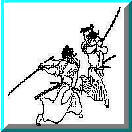B
BBu: Martial. In Asia, from remote
times the lance has been the symbol of the soldier. Used in the handwriting in
its ideográfica form, the lance is the base of many kanji. This is the root of
bu, the area code used in a great number of words related to the things of
martial nature. Thus we have bugei (the martial abilities or martial arts),
bushi (the educated feudal class of soldiers), and buke (an ancestral family of
soldiers).

It would seem logical that the
symbol of the lance by itself was sufficient to connotar military man, but in
kanji to express bu, ideograma for lance is accompanied by other outlines that
mean "to suppress a revolt." Thus the symbol for military man talks about "to
choke a revolt with the use of the lance." To choke the revolts has been the
task of the military service in almost all the civilizations. And in Japan more
than in no other place this it was the main task of the chaste single-breasted
uniform jacket. In the best one of the times, the troopses restored La Paz and
promoted the culture. In the worse ones, they imposed a cruel oppression and
they squashed the spirit of the town. Thus bushi, the class armed in old Japan,
was as much heroes for the town, like a tool of the tyrants. The lance used in
the Japanese martial arts, yari, is not a to be sent weapon. It was grasped in
the battlefields like a twig. The leaf of yari this sharpened to be able to be
nailed in the body of the enemy, but in addition the typical leaf long and is
sharpened by both ends, therefore yari I could also be used to cut to the right
like a the left. Of here the tendency of which ideograma of yari, like a weapon
that cuts in opposed directions, is the base of so many words related to the
martial thing, because like the soldier of nowadays, bushi in the Japanese
feudal society could cut in both senses; for or or badly.
ART. EXTRAIDO OF INTERNET